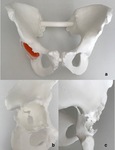Learning objectives
Periprosthetic acetabular fractures represent an uncommon but challenging complication of total hip arthroplasty (THA).
Learning objectives of this EPOS are to show:
a newapproach using 3D modelling software to improve the assessment of fracture morphology and bone quality.
theuse of 3D modeling and rapid prototyping (3D printing) for the diagnostic process of periprosthetic acetabular fracture around THA.
the use of 3D real-life size model for preoperative implant templating, sizing and surgical simulation.
Background
Periprosthetic acetabular fractures are related to traumatic events and pathologic underlining conditions that reduce the structural integrity of supporting bone[1] and often are associated with aseptic loosening, periprosthetic osteolysis and severe bone loss[2].
Analysis based on standard radiographs alone are not suitable to reliably detect the residual stability of the implant and measure the extent of the fracture and pelvic bone loss [3].
CT scan is the gold standard to define the fracture pattern,especially with 3D virtual rendering reconstructions and specific metal artefact reduction (MAR)...
Findings and procedure details
A 75-year-old female presented to the emergency department in September 2018 after a domestic trauma. She had the history of right hip severe coxarthrosis treated with cementless THA in 1998.
The patient underwent anterior-posterior (AP) radiographs of the pelvis and a cross-leg view of the hip. No signs of fracture or any sign of loosening around the acetabulum and the stem were evident Fig. 1.
CT scan of the pelvis with MAR protocol revealed a fracture of the posterior wall of the acetabulumapparently with annon-displaced...
Conclusion
The use of 3D modeling software showed that periprosthetic acetabular fractures can be better addressed, compared to plain radiograph and CT scans.
3D modeling software provide additional measurement tools which allow the volumetric analysis of bone defects and bone quality assessment.
Digital and 3D printed models can be used for preoperative surgical planning and templating. Moreover can be used as a guide tool on the operative field.
Personal information and conflict of interest
R. Prost; Cagliari/IT - nothing to disclose M. Giuseppe; Cagliari/IT - nothing to disclose A. Capone; Cagliari/IT - nothing to disclose
References
Benazzo F, Formagnana M, Bargagliotti M, Perticarini L. Periprosthetic acetabular fractures. Int Orthop. 2015 Oct;39(10):1959–63.
2. Capone A, Peri M, Mastio M. Surgical treatment of acetabular fractures in the elderly: a systematic review of the results. EFORT Open Rev. 2017 Apr;2(4):97–103.
3. Kitamura N, Pappedemos PC, Duffy PR, Stepniewski AS, Hopper RH, Engh CA, et al. The Value of Anteroposterior Pelvic Radiographs for Evaluating Pelvic Osteolysis: Clin Orthop. 2006 Dec;453:239–45.
4. Gupta A, Subhas N, Primak AN, Nittka M, Liu K. Metal Artifact Reduction. Radiol...





